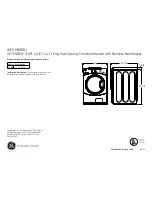
7
2. Rinse Agents
a)
Always use a liquid rinse agent,
even if your detergent contains a rinse
agent or drying additive.
3. The Detergent and Rinse Agent
Dispenser
- Filling the Detergent Dispenser
a) Fill the dispenser cup as
recommend in Table 1.
b) Slide the detergent dispenser cover
in the direction shown in Figure 14A and
press it down firmly as shown in Figure
14B so that the cover snaps shut.
- Opening the Detergent Dispenser
Cover
NOTE: To open the detergent
dispenser cover, press the blue release
in the direction shown in Figure 15.
Pressing down on the release tab will
not open the cover.
c) Press the blue release tab in the
direction shown by the arrow in Figure
15.
d) The cover will slide open to the right.
- Filling the Rinse Agent Dispenser
e) Open the rinse agent dispenser by
pressing the star on the cover with your
index finger while lifting the tab with your
thumb as shown in
Figure 16.
Figure 16
f) Add liquid rinse agent to the
dispenser as shown in Figure 17A until
the rinse agent reservoir is full. Wipe up
any excess rinse agent that puddles
when the dispenser reservoir is full.
g) Return the rinse agent dispenser
cover to its shut position and press it
firmly so that the cover snaps shut.
NOTE
: Figure 17B represents a
completely empty rinse agent
reservoir.
h) Refill the rinse agent dispenser
when the rinse agent reservoir level
indicator as shown in Figure 17B
begins to show a silver background with
black lines or when the Refill Rinse
Agent indicator comes on.
Figure 18
a) Use only detergents specifically
designed for dishwashers.
b) The detergent dispenser cup has
lines that measure detergent to 15
milliliters (ml) and 25ml. 45ml of
detergent will completely fill the
detergent dispenser cup.
DISHWARE DAMAGE:
Too much
detergent in soft water may cause
etching in glassware. Do not use too
much detergent if your water supply
is soft.
C A U T I O N
NOTE
:
If you do not know the
hardness of your water supply, use 15ml
of detergent. Increase the amount of
detergent, if necessary, to the least
amount required to get your dishware
and kitchenware clean.
c) Use the measuring lines in the
detergent dispenser cup as a guide to
measure the amount of detergent
recommended in Table 1.
To adjust the amount of rinse agent
dispensed:
i) Open the rinse agent dispenser
cover.
j) If your dishes are streaked after
washing, turn the regulator to a lower
number.
k) If your dishes are spotted after
washing, turn the regulator to a higher
number.
Water Type
Wash
Cycle
Power
Scrub
Plus
Regular
Wash
Delicate/
Econo
Hard
Medium
Soft
45ml
45ml
25-45ml
25-45ml
25ml
15-25ml
25ml
15-25ml
15ml
Rinse &
Hold
None
None
None
NOTE
:
After filling the rinse agent
dispenser, the Refill Rinse Agent
Indicator will go out in a few minutes after
the dishwasher door is shut.
- Rinse Agent Dispenser Regulator
The amount of rinse agent dispensed
can be regulated to control spotting and
streaking. The Rinse Agent Dispenser
Regulator as shown in Figure 18 leaves
our factory set at 4.
USING YOUR DISHWASHER
Adding Detergent and
Rinse Agent
1. Detergents
DISHWASHER DAMAGE:
Using hand
dishwashing products in your dish-
washer could damage your dish-
washer. Do not use hand dishwashing
products in your dishwasher.
C A U T I O N
Figure 15
B
Figure 17
A
B
Figure 14
A
B
Table 1
Operating the Dishwasher
1. Select the Proper Wash Cycle
a) Items with baked-on or hard, dried-
on soiling will require either Power
Scrub Plus or possibly soaking and
hand-scouring.
b) The Regular Wash cycle will
thoroughly clean large loads having
loosely attached normal soiling.
c) The Rinse and Hold cycle will allow
you to keep a small load in your
dishwasher until you have enough items
for a full load.
Содержание Integra SHX46L02UC
Страница 1: ...DISHWASHER USE AND CARE MANUAL For MODEL SHX46L YOUR LIFE OUR INSPIRATION 9000022090 Rev A ...
Страница 2: ......
Страница 16: ...14 ...
Страница 30: ...14 ...










































